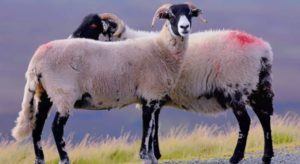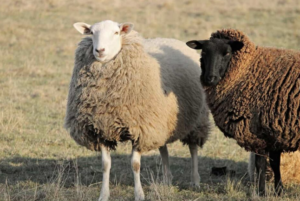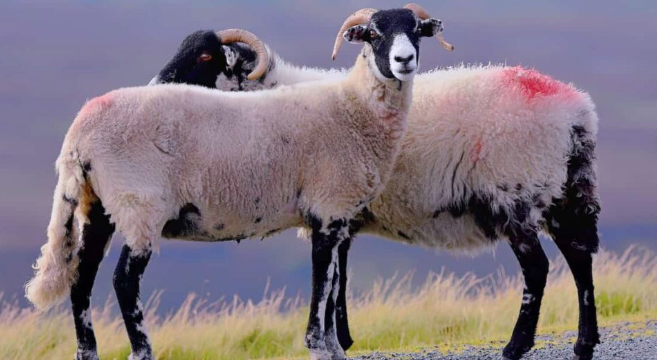Sheep Farming in New Zealand: In New Zealand, sheep farming has been practised for ages and is a significant business. Producing high-quality meat and wool, sheep farming is a significant sector of the agricultural economy.

How to begin raising sheep in New Zealand
One of the most significant agricultural sectors in New Zealand is the sheep farming business. It makes a sizable economic contribution, supports a sizable workforce, and produces sizable export earnings. The sector plays a significant role in supplying the local market with food and fibre.
Is New Zealand’s sheep farming industry profitable?
The best wool in the world is produced in New Zealand, where sheep husbandry has a long tradition. Sheep farming in New Zealand may take many distinct forms, including pastoral (growing sheep for their meat), mixed farming (producing both sheep and cattle), and intensive farming (raising many lambs).
If the correct circumstances are there, sheep farming is profitable in New Zealand. For instance, the environment must be chilly enough to prevent the fleece from being harmed by sunshine, there must be enough grass for the sheep to graze on, and there must be sufficient water supplies. In order for the flock to effectively reproduce, it is also critical to have an effective breeding programme in place.
Sheep farming requirements in New Zealand
As a result of its plentiful land, pleasant climate, and heavy rainfall, New Zealand is one of the top nations in the world for sheep farming. More than 300 different varieties of sheep are now raised in New Zealand, where shepherds have been doing so since before the arrival of the first Europeans. You will require access to high-quality pastureland (at least 320 hectares), sufficient water supply (at least 400 litres per hectare), and fertile soils (enough organic matter) in order to effectively rear sheep in New Zealand.
As well as shelter (such as sheds or windbreaks), year-round food and water, veterinary treatment, and tools like shears, rams, and waggons for transporting herds across your land, you must also offer these things for your flock.

Zero grazing sheep farming in New Zealand
A new kind of sheep ranching that has lately gained favour in New Zealand is zero-grazing. With this kind of sheep husbandry, the animals may hunt for food without human assistance. The idea behind this strategy is that by making more food available to the sheep, their productivity and health would increase.
There are difficulties with New Zealand’s zero-grazing sheep ranching. For starters, it might be challenging to keep the sheep out of locations where they can reach food that is given by people. Additionally, a lack of human monitoring has led to overgrazing issues, according to several farmers. However, this style of sheep farming is regarded to be more ecologically friendly and sustainable than conventional ranching practises, and it appears that it will likely continue.
New Zealand sheep farming for beginners
- In New Zealand, there are numerous methods to start a sheep farm. Purchasing a portion of an existing asset is one possibility. A different choice is to buy your land and build from scratch. A number of sheep farming companies also provide leasing and purchasing choices.
- After deciding on a strategy for getting started, the following step is to locate the ideal home. You must choose the sort of farmland you want, whether it is flat or hilly, and if you want to buy the property outright or lease it. After you have selected these choices, you should begin looking at houses.
- To discover suitable land, you can utilise internet tools like databases and maps. To be safe, always talk through the details of the agreement with landowners before signing anything.
- The next step after finding a property is to get it ready for sheep farming. Building fences around the property, creating sheep pens, and clearing the ground of trees and other plants are all necessary steps in this process.
- A wonderful method to enter the agricultural industry in New Zealand without making a sizable initial investment is through sheep farming. You may alternate between raising lambs and making wool items, making it a versatile pastime.
Tips for sheep farming for beginners in New Zealand
- Make a solid choice of your property.
- Choose the breed of sheep that you want to keep: Polled, Shorn, or longwool
- Find out what other farmers in the region are doing by speaking with them.
- Do some research on the sheep breeds that are most appropriate for your area and environment.
- Make that you have access to pasture, hay, and fresh water.
- Install fence to keep animals and predators away from your sheep.
- During the cold months, give your sheep extra food.
- Trim the wool on your pets on a regular basis to prevent matting.
-
Get your sheep immunised to protect them from illnesses including Rotavirus, Typhoid fever, and Foot-and-Mouth Disease (FMD).
-
To make sure everything goes as planned, keep a tight check on your sheep throughout lambing season.

Sheep farming areas in New Zealand
One of the oldest and most significant agricultural enterprises in New Zealand is sheep farming. The nation has a long history of sheep husbandry, which led to the development of a thriving sheep industry. In New Zealand, there are about 115,000 sheep, and there are typically 2,500 sheep each flock. The North and South Islands of New Zealand are where sheep farming is practised.
The provinces of Canterbury and Otago in the North Island are where most farms are concentrated, whereas Nelson and Marlborough are where most farms are concentrated in the South Island. On sheep farms in New Zealand, the two major products are wool and mutton, while some farmers also cultivate honey, lamb chops, and other types of meat.
The world’s greatest sheep farms are found in New Zealand, which has a long history of sheep farming. Sheep are now raised in Northland, Waikato, Taranaki, Manawatu-Wanganui, Canterbury, and Otago in New Zealand. Each location has distinct characteristics, such as a particular temperature, topography, and soil type, that make it ideal for sheep farming.
Sheep breeds in New Zealand
| Australian Whites NZ | Poll Dorset |
| Awassi | Polwarth |
| Border Leicester | Romney |
| Charollais | Ryeland |
| Corriedale | Shropshire |
| DairyMeade NZ | South Suffolk |
| Dorper | Southern Cross |
| Dorset Horn | Suffolk |
| East Friesian | Texel |
| English Leicester | Valais Blacknose |
| Finnsheep | Zealandia |
| Hampshire | Barnyard Sheep |
| Lincoln | Flock Sheep |
| Merino | Romney Sheep |
Management of sheep feeding in New Zealand
Since sheep farming is a relatively young sector in young Zealand, there is still a lot to learn about the ideal methods for managing sheep feeding. However, the following advice might assist you in enhancing the health and output of your flock:
1.Fencing off unused areas will help you reduce the grazing burden on your pastures.
2.Depending on the weather and pasture occupancy, provide more feed at particular times of the day.
3.To maintain a varied and fascinating diet, rotate the feed kinds you provide your sheep. Both their health and boredom will be improved by doing this.
4.Regularly check the health of the flock using faeces samples, blood tests, and physical examinations to look for any early symptoms of illness or damage.

Sheep farming types in New Zealand
In New Zealand, there are several sheep farming companies. Intensive, extensive, and mixed sheep husbandry are the three basic categories. When a farmer raises sheep intensively, they are fed a high-quality food and come in large numbers. When a farmer raises sheep extensively, they keep fewer lambs and let them graze on local shrubs and grasses.
The farmer who owns both vast and intensive sheep farms is said to practise mixed farming. In New Zealand, a wide variety of sheep breeds are bred, from ewes that produce meat and wool to hybrid varieties that produce both fibre and meat. The following sheep species are most prevalent in New Zealand:
1.The most common breed of sheep in New Zealand and one that is frequently utilised for its wool is the fine-wool sheep. They often have a short, crimped coat of wool, which makes them incredibly plush and silky.
2.Sheep Used for Meat: Sheep used for meat produce meat that is generally used for lamb but can also produce mutton. They often weigh more than fine-wool sheep and have lengthier coats of hair that are either black or brown.
3.Sheep With a Dual Purpose: Sheep with a dual purpose may provide both fibre and meat. They often generate a lot of wool and have a lengthy coat of hair that is predominantly white with some black strands thrown in.
How should sheep be raised in New Zealand?
In New Zealand, raising sheep is a common practise for producing meat, wool and milk. Sheep are largely disease-free and require little maintenance. They may be shorn or allowed to graze and require little nutrition.
In New Zealand, sheep farming is primarily restricted to the South Island’s highlands. If you want to farm sheep for a living, you’ll need an agricultural visa. You don’t need a permit if you’re keeping the sheep for your own use.
Early fall through the winter are the optimum months to rear sheep since that is when they consume their winter hay supply. Then, in the late summer or early fall, you may start feeding them clover, but be careful not to overdo it since too much clover might make them ill.
Give your sheep plenty of access to clean water and a decent pasture (a combination of grass and wood chips) to keep them healthy. To prevent them from becoming dispersed during lambing season, you might wish to construct a pen if you have more than a few lambs.

Sheep marketing in New Zealand
- In New Zealand, sheep farming is profitable and gives farmers access to high-quality meat and wool products. In New Zealand, sheep are the most typical animal kept on farms. They are produced for their meat, wool, and milk.
- New Zealand’s moderate climate and plenty of resources make it the perfect place for sheep ranching. On farms in New Zealand, there are over a million sheep, and the sector is expanding quickly.
- Sheep farming pays well and gives farmers access to premium meat and wool products. With over 600,000 sheep roaming the hills and plains of New Zealand, sheep ranching is a significant industry there. Although a rising demand for wool goods exists, most of these sheep are bred for their flesh.
- The majority of sheep in New Zealand are raised on enormous industrial farms. These enterprises vary from modest family-run farms that primarily raise lamb and wool to huge multinational corporations that manufacture meat and fibre goods.
Business plan for sheep farming in New Zealand
1. Determine the expenses involved in operating a sheep farm in New Zealand.
2. Create a business plan that takes your target market and pricing strategy into consideration after researching the New Zealand sheep farming sector.
3. Create a solid management team with skilled workers to run your farm.
4. Establish infrastructure, secure the property, and begin flock selection.
5. Implement your business strategy to expand your sheep farm, concentrating on high-quality output and client pleasure.
6. To stay competitive, uphold strict standards for animal welfare and environmental management.
Are sheep profitable on a small farm?
- The quick response is that sheep farming in New Zealand may be successful on a modest scale, but it requires a lot of effort and commitment. Nevertheless, sheep are a wonderful choice for small-scale farmers since they are adaptable creatures that may primarily be utilised for the production of meat, wool, and milk.
- In order to start a small-scale sheep farming business in New Zealand, you need to get permission from the government. You must construct or buy a pen for your sheep as soon as you receive authorisation. Additionally, you’ll need to supply your flock with food and make sure they have access to water.
- There are various methods to boost your revenue from sheep farming in New Zealand, which is quite profitable. You may, for instance, market the meat or the wool your sheep generate.
Large-scale sheep farming in New Zealand
- In New Zealand, large-scale sheep farming is a well-liked and lucrative agricultural sector. In New Zealand, there are presently about 100,000 sheep on farms, and the industry is expanding quickly. For farmers who wish to produce animals for meat, wool, or milk, sheep farming is a suitable choice since it has a little impact on the environment.
- Large farms allow sheep to graze freely while being reared there. They are shorn once a year and given hay, veggies, and grain. Wool that can be sold commercially is produced during shearing. Lambs are also killed for their flesh in addition to their wool.

Sheep farming profits in New Zealand
New Zealand’s sheep farming sector makes $1.3 billion in earnings yearly. This astounding number is mostly due to the nation’s high wool output, which is worth more than $1 billion yearly. The sector also has a large workforce, with an estimated aggregate employment of over 26,000 workers.
Sheep farming loans in New Zealand
- In New Zealand, sheep farming has been practised for more than 150 years and is a well-liked industry. In New Zealand, there are numerous options to obtain financing for sheep farming, including public loans, private loans, and family lending programmes.
- Government loans are provided for a number of things, including buying or constructing infrastructure for sheep farming. Family loan programmes offer assistance to farmers who are equally responsible for running the farm. Banks, finance businesses, and other financial entities offer private sector loans. Building sheep husbandry infrastructure and buying sheep are both possible with loans.
- In New Zealand, sheep farming may be successful if the right investments are made. Farmers that have financial means and experience can profit from significant investment returns.
Sheep farming problems in New Zealand
New Zealand has a long history of sheep husbandry. But during the past few years, there have been a number of issues with sheep farming in this nation. Among the most significant issues are the following:
Overgrazing: Sheep grazing on open grassland has the potential to swiftly overgraze a region, leading to soil erosion and desertification.
Leeds disease is an illness that frequently affects sheep, especially young lambs. Due to fluid buildup in the lungs, it results in pneumonia or asphyxia death.
Many people think that farmers are to blame for every issue with sheep farming in New Zealand, but the truth is that there are just too many sheep for the available terrain.
Challenges faced by New Zealand sheep farmers
The primary difficulties faced by sheep farmers in New Zealand are the weather (including extreme weather events), pests and illnesses (including bovine TB), and competition from other livestock farms. Nevertheless, these difficulties have spurred innovation within the sector, leading to the creation of novel sheep breeds that can withstand certain weather conditions or resist pests and illnesses.
The fact that New Zealand has a moderate temperature and hence there aren’t as many options to provide hay for livestock as in warmer regions presents a difficulty for sheep producers there. In order to give their sheep enough food and nutrition, they must consequently find alternative means. Learning how to control parasites and illnesses presents another difficulty for novice sheep ranchers. In order to maximise the use of their soil, they will also need to become knowledgeable about its many varieties and farming techniques.
Conclusion
The largest producer of lamb and wool worldwide is New Zealand. The nation also boasts a large number of dairy cows that provide milk for making cheese and other goods. However, with roughly two million sheep in the nation today, sheep continue to play a significant role in New Zealand’s agricultural industry. Overall, sheep farming is one of the most profitable activities in New Zealand.


